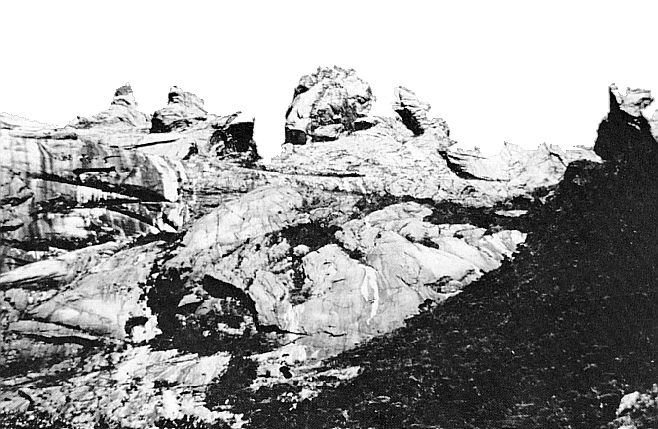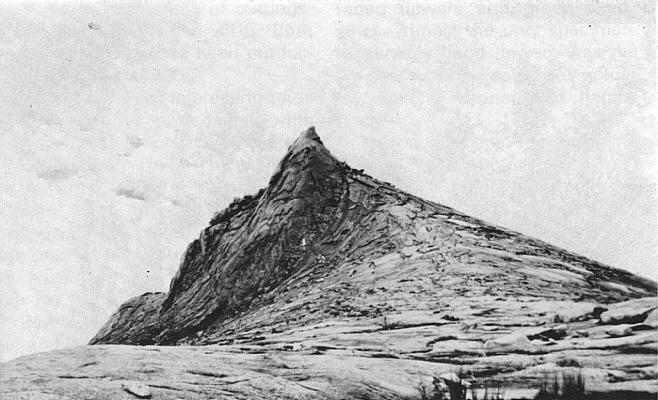Rhododendrons on Malaysia's Highest Peak, Mt. Kinabalu
F. L. Doleshy, Seattle, Washington
Mt. Kinabalu has been climbed and botanized since 1851, but a large part of its plant life is still unknown. Geographically, it is six degrees north of the equator, in Borneo, and is the highest mountain between New Guinea and Mainland Asia; its 13,455 foot summit is more than 300 feet above Mt. Morrison, in Taiwan.
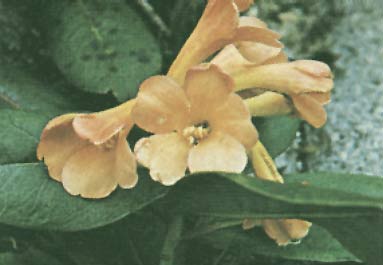
|
|
R. lowii
Photo by Frank Doleshy |
Of the 27 so-far-discovered rhododendron species on Kinabalu, about 11 are known from this mountain only, and most of the others are found only in Borneo. One rhododendron or another is encountered from the coastal lowlands to the granite summit rocks, with a great concentration of varied species between 7,000 and 11,000 feet. One of the most robust is
R. lowii
, growing to a height of 23 feet and sometimes taller, with leaves up to 9 inches long and half as broad. This has been found as low as 6,500 feet but thrives above 11,000 feet. At the other end of the size scale is
R. ericoides
, with leaves a quarter inch long and about 1/25th inch wide. This grows within 50 feet of the summit. Another species is
R. stenophyllum
, with leaves almost the shape of pine needles and flowers like shiny bells. Mrs. Doleshy and I were very much interested when we saw a photo of this in one of Dr. Sleumer's papers, and, the eventual outcome was our trip to Borneo.
On September 10, 1976, we drove to Vancouver, B.C., and checked in at noon for Canadian Pacific's flight via Tokyo to Hong Kong. This 6600 mile journey ended when we walked into our hotel room at midnight - but the elapsed time since noon had been stretched to 20 hours by crossing eight time zones. The next morning at 10 a.m. we were off again on one of Malaysian Airline System's jets and went almost due south 1140 miles to Kota Kinabalu, the principal city of Sabah. Sabah was formerly British North Borneo and is now one of the states of Malaysia.
The next three days were spent on a variety of jobs: arranging for the extension of our visitor permits from 2 to 3½ weeks; getting acquainted with the bank where we had our Malaysian dollar checking account; figuring out and buying 80 pounds of food for our stay on the mountain; and taking a taxi to one suburban gas station after another to find the kerosene we would need for cooking. In making these preparations we relied heavily on the advice of Mr. D. V. Jenkins, Assistant Director, Sabah National Parks, with whom we had corresponded during the preceding eight months. Also, permission is necessary to collect plant material in Kinabalu National Park, and Mr. Jenkins had granted this. Now that we had the opportunity, it was a great pleasure to meet him in person.
Finally we went via Land Rover to National Park Headquarters, in the foothills at an elevation of 5121 feet. After more preparatory work, and a walk through the magnificent oak-chestnut-conifer forest of the 4000 to 6000 foot elevations, we were ready to go uphill. This was our first trip to Mt. Kinabalu, indeed to any high elevation tropical terrain. For a good introduction, Mr. Jenkins suggested that our principal base of operations be Panar Laban. This is a locality on the south ridge where the main summit trail emerges from shrub and tree vegetation and continues upward on the steep granite dome. Aluminum huts have been set up here, mainly for summit climbers, pending the construction of a more permanent shelter. The average elevation is about 10,800 feet, and Mr. Jenkins' photos indicated that we could find a variety of plant communities nearby.
Starting the ascent from Park Headquarters to Panar Laban, one first rides a Land Rover to the power station at 6200 feet, if fortunate, and then proceeds on foot. Two non-athletes, such as ourselves, would not be able to carry 80 pounds of food along with sleeping bags, air mattresses, clothing, collecting gear, etc. However, members of the Dusun tribe work as porters, and we hired five of them to, do the heavy carrying while we walked up more or less blithely with rucksacks weighing less than 15 pounds each.
We had not really believed a travel book which described the trail as "terraced stairs". Actually, roots have been exposed by erosion, and additional pieces of wood have been pegged in to keep the steeper places from washing out. With these aids, the difficulties were not great. But, at least for us, the trip required a considerable amount of effort.
To our delight, the first rhododendron we saw on the way up was the
R. stenophyllum
which, above all, had lured us to Borneo. This was a flowering specimen at an elevation of 6225 feet, and it was immediately recognizable by the narrow leaves, 2 or 3 inches long and 1/10th inch wide. The flowers were at the end of lanky shoots and about an inch long, as shiny as if lacquered and usually in two's or three's. The colors we saw were clear and vivid orange-scarlet, in the range of 33B, 34A and 34B on the Royal Horticultural Society Colour Chart.
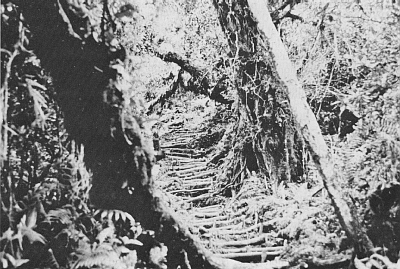
|
|
Steep trail in the mossy forest, elevation 6000 to 8000 ft
All photographs by the Doleshys |
The elevation range of this plant extends from 5000 to 11,000 feet, but Dr. Sleumer has told us that it is rather local in distribution, being common along the main south ascent route but absent at similar elevations a few miles to the east. We saw a particularly large number of plants between 8000 and 8400 feet, usually in some shade, growing on steep, rocky slopes or colonizing the moss-covered surface of decaying logs and living tree trunks. At the rhododendrons' roots, the pH was 3.8 for the rocky soil and 3.5 to 3.6 for the humus layer under the moss on downed logs.
For propagation of this and other rhododendrons found in the mossy locations, we obtained some rooted material and some ordinary shoots. The
R. stenophyllum
collection was No. 660, from elevations of 8200 to 8350 feet.
Upon return to the U.S.A. we inserted our share in an ordinary sand-peat mixture but became concerned when we found that the pH was about 5.8. This brought to mind our successful 1961 experiment with decayed wood as a medium for growing rhododendron seed, so we tested an old fir log in our garden. The reading was 3.7, and we added fragments of this wood to the top of the growing medium for
R. stenophyllum
and other rhododendrons from similar sites. This was not a controlled experiment, but we saw new growth very soon, and nearly all of this propagating material has succeeded.
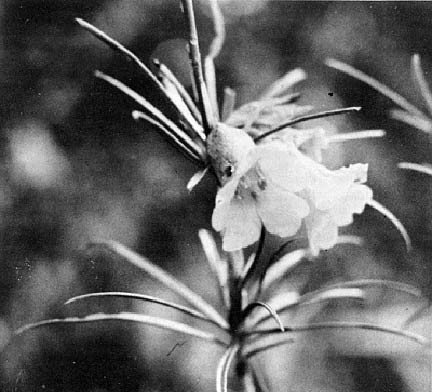
|
|
R. stenophyllum
at about 8000 feet
The flowers are orange-scarlet. |
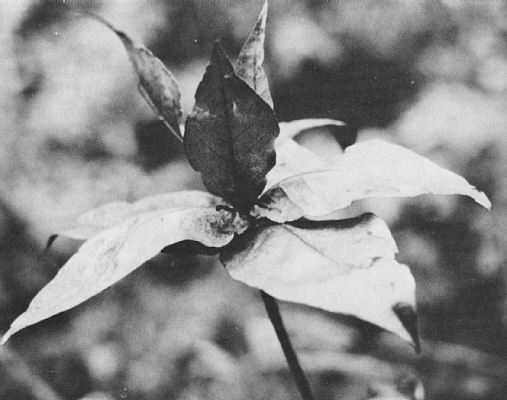
|
|
New foliage of
R. fallacinum
at the golden-yellow stage.
7500 feet |
We also collected seed of
R. stenophyllum
, as No. 601, but this was evidently too green to ripen and germinate. Soon after finding the first
R. stenophyllum
we noticed the distinctive foliage of
R. fallacinum
. These leaves often have an up-and-down waviness at the edge, and they are practically without leaf stalks, thus appearing to grow directly from the trunk or branch. They are so densely covered with scales that the top surface is silvery when very young, then turns a yellow ochre or gold color. The recorded range is from 4000 to 8500 feet, and the highest plants we saw were vigorous specimens at 8000 feet. They are more often terrestrial than epiphytic, as we observed.
Ten to thirty flowers make up a cluster, and this is in the form of an umbel, i.e., with all flower stalks apparently coming from one central point. We arrived too late to see these flowers at their best but thought them very attractive. Those we saw were all a light scarlet ((R. H. S. Colour Chart) No. 43C), but Dr. Sleumer records various other colors from rose-purplish to deep orange pink with a deep pink center. Our introduction (No. 663) consisted of cut material from a 7500 foot site where the pH was 3.5. Dr. Sleumer has since suggested that the species may be new to horticulture; this surprises us, but we are happy to have brought it in.
A small-leaved rhododendron often seen in the vicinity of the above two is
R. quadrasianum
var.
cuneifolium
.
R. quadrasianum
is common in the Philippines, where a host of forms occur, but the var.
cuneifolium
is confined to Borneo and (once found) S.W. central Celebes. As indicated by the name, the leaf is wedge-shaped, and it broadens toward the tip. The plant is usually terrestrial and is upright but neat and densely foliaged. It often grows to a height of 3 or 4 feet and sometimes becomes a treelet.
The usual range of elevations is 5400 to 9400 feet, and we found it plentiful with the
R. stenophyllum
at 8200 feet. No flowers were to be seen on this species during our stay, but introductions from the Philippines have frequently flowered at our home, and we enjoy the good crops of little red-pink tubular flowers, ½ to ¾ inch long. Our cut material for propagation (No. 661) was from a site where soil pH was 3.6, and this has grown well. Also we obtained seed at an elevation of 7750 feet, as No. 652, and this has germinated fairly well.
The mossy forest, where we saw these three rhododendrons, is the famous zone of clouds and mist where mosses grow on the soil surface and densely pad the fallen logs; also they clothe the trunks and branches of living trees. Our reaction to this zone was mixed. As an abode of mosses, it hardly seemed to match the Hoh River Valley and other "rain forest" valleys along the ocean coast of the state of Washington, 90 miles west of our home. Here, sphagnum grows on the ground, and the great weight of mossy drapery seems to bend the trunks and limbs of trees more than on Mt. Kinabalu. However, the moss on the trees and rocks of Kinabalu is inhabited by a greater variety of other plants, including rhododendrons and especially orchids.
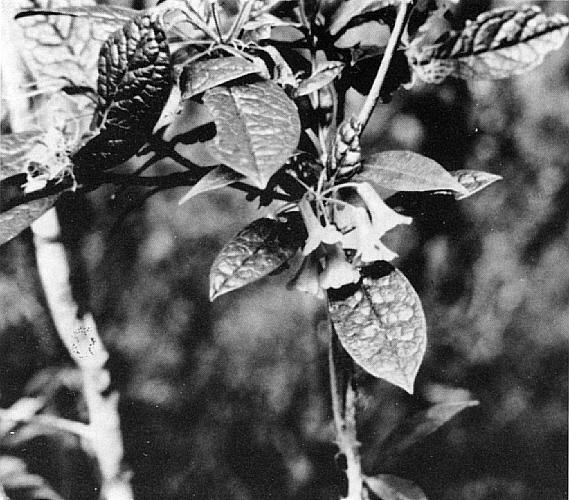
|
|
R. rugosum
var.
rugosum
In the forest at about 8000 feet. |
Two rhododendrons are first seen while one is climbing up through the lower levels of the mossy forest, but both extend to elevations considerably above the zone of heavy moss. These are
R. rugosum
var.
rugosum
and
R. acuminatum
, each with rugose or bullate leaves, i.e., leaves in which the veins and veinlets are deeply impressed above and stand out beneath, giving the leaf surface a three-dimensional pattern from either side.
R. rugosum
var.
rugosum
seemed somewhat the more common of the two. With flowers which are usually rose to crimson, and with leaves of a conventional elliptic shape, this is perhaps a comforting rhododendron to those brought up on Himalayan species and standard garden hybrids. Yet it is beautiful indeed, and the flowers have given pleasure to February visitors as well as ourselves in September-October.
The plants we saw were terrestrial and usually 6 to 15 feet tall, but this species is also found growing epiphytically, and it sometimes reaches a height of 30 feet or more. Flowers were usually 10-12 per cluster; those checked with the (R. H. S. Colour Chart) were in the range from 55A to 57C.
R. acuminatum
grew in the same localities, and, with this plant, exoticism returned to a high note. At first glance, the acuminate (i.e., drip-tip) leaves with embossed surfaces might have been taken for those of
R. bullatum
or
R. edgeworthii
, but who ever saw one of the latter plants with orange-scarlet flowers? Also, the branchlets and leaf undersurfaces of the
R. acuminatum
looked as though a continuous coating of crushed garnet had been glued on. This, of course, was the dense coating of scales which characterizes the Malayovireya Subsection of the Vireya rhododendrons. Flowers were commonly 10-15 per cluster. Those we saw, in September-October, approximately matched (R. H. S. Colour Chart) Nos. 3313-40C.
In the mossy forest, the growing media for both
R. rugosum
var.
rugosum
and
R. acuminatum
are probably in the pH range of 3.5-3.8, but values of 4.7-4.8 are likely on the open ridges, and we consistently read 4.7 in the portion of the high elevation scrub forest (ca. 11,000 feet) where these plants occur. From the scrub forest we collected
R. rugosum
var.
rugosum
seed as No. 603 and cuttings as No. 613;
R. acuminatum
seed as No. 602 and cuttings as No. 612. We do not know of any success with these collections, although seed may have grown for someone.
Another collection, No. 651 A and B, consisted of cuttings from plants at about 8200 feet which lacked flowers or seed capsules. These may have been
R. rugosum
or may have been the somewhat similar
R. maxwellii
. This latter species is rather rare, and the flower color is usually yellow but sometimes deep cream to pink or pale salmon. At least three of these cuttings appear to be growing.
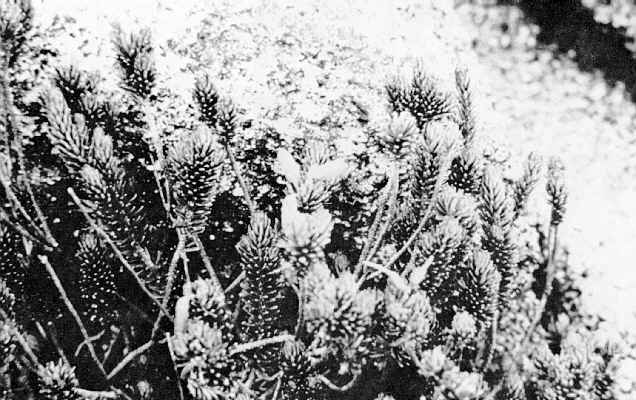
|
| R. ericoides near the summit is a dweller of the cracks in granite. |
The earlier-mentioned
R. ericoides
is as heath-like as its name implies. The flowers are like small, elongated thimbles, and the leaves grow densely all around the stem in the upper part of each branch. This species extends down into the mossy forest. To us, however, it was not very noticeable until we passed Paka Cave, at ca. 10,500 feet, and started up the steep slope to Panar Laban. Here, it grew to a height of 6 or 7 feet, with a few flowers at the time of our visit - perhaps one or two on every second or third plant. Above Panar Laban it was a dweller of the cracks between bare granite plates, but plants up to two feet tall could still be found in sheltered spots to an elevation of 12,750 feet or so. Continuing upward, its stature decreased; the last plant I was able to find, at about 13,400 feet on the summit pyramid, was only a few inches tall, with leaves about 3/16ths inch long, but it was highly vigorous, with bronze-tipped dark green foliage. Flowers at 10,000 to 12,000 feet were normally scarlet, but those toward the summit were often on the orange side or, less commonly, a purplish red.
Our cuttings of this plant (No. 607) largely succumbed during the unbelievably slow airmail trip across the Pacific, but a few of the seeds are germinating; these are our No. 617, from 12,000-13,000 feet, and our No. 625, from 10,700 feet.
Even in a rhododendron publication, some of the other plants of Mt. Kinabalu need mention. Most astonishing to us were the
Nepenthes
, with liquid filled pitchers for trapping and digesting insects. These pitchers, from an inch or two up to 7 or 8 inches long, have nothing to do with the flowers and are borne at the end of tendrils which are long extensions of leaf midribs. As the early-day botanists knew, the fluid inside a young pitcher can be used as drinking water, but it becomes less desirable after it has digested some ants or a butterfly.
Orchids are there too, the number of species on the mountain being estimated as 800 to 1000, and these are only partially worked out. Species along the main summit route, we thought, would be well known and common in cultivation - and we have since been surprised to find that our orchid-expert friends are baffled and fascinated by our pictures.
Then there is
Leptospermum
, almost ever-present at the higher elevations. At about 9000 to 9500 feet, some of the yellow soils derived from serpentine rock seem to be unfavorable for most plants, and the
Leptospermum
has few companions; it grows as gaunt, sinuous little trees, a few yards apart and looking more or less like sagebrush which had grown very large.
At the end of our long and fascinating walk we finally came to the Panar Laban huts, mostly rather cold and cheerless structures. We were, however, fortunate enough to enjoy the comparative luxury of Burlington House, located at 10,800 feet in the vicinity of the other huts. Burlington is normally reserved for staff and VIP use; it has a pot-bellied-wood stove, an inside faucet and sink, and quite an expanse of wooden floor between the bunks. Originally it was carried up onto the east ridge of Mt. Kinabalu and erected by the 1961 Royal Society Expedition, who gave it the same name as their London headquarters building.
Because of greater need for shelters on the main ascent route, this building was eventually taken apart, brought over, and reassembled. For us it was a most pleasant operating base, and the stove was a real comfort. Seven a.m. temperatures, measured for seven days, ranged from 41½° to 45½° F., and the approximate daily maximums ranged from 48° to 55° F. Outdoor work at such temperatures can be hard on the hands, and we found that we should have taken a larger supply of hand lotion.
During portions of our stay we were joined by Mr. Jukian, the senior ranger of Kinabalu National Park, and his two assistants, Mr. Biun and Mr. Dampuran. They had a good knowledge of the plants and were helpful in many ways, as well as being very enjoyable companions.
From Burlington House we went out in every direction, including upward to the summit of the mountain, but we could find things of interest without going far. A few steps from the door was a plant of
R. buxifolium
var.
robustum
, with its rounded, inch-long leaves growing densely on the shoots. This plant leaned out from the slope, with a trunk diameter of 7 inches near the ground and a trunk length of about 17 feet. The top was much branched and consisted of several umbrellas of foliage grown together. Only one cluster of blood-red flowers remained, and we had obviously missed a real show, since the top of the plant was so thickly studded with immature seed capsules that it appeared brownish.
Similar crops of seed capsules made it easy to find sister plants in the vicinity. Some of these were upright to heights of about 20 feet, and others leaned at various angles. Soil pH was 4.7-4.8. We sent back both cuttings and seed as No. 606. A few of the cuttings appear to be successful, but the seed was evidently too green.
This rhododendron was one of the tall plants which provided the upper story of foliage in the woodland near Burlington. Another such plant was
Schima brevifolia
(or
Schima wallichii
var.
brevifolia
), a member of the tea family with camellia-like white flowers and beautiful new foliage. With sun shining through the leaves from above, the lower surfaces lighted up with a wine-red glow, while the top surfaces had an overlay of soft blue on a deep maroon background. (We gathered seed as No. 624.)
Numerous gaps and breaks in the upper foliage canopy let enough light come through for an understory of smaller shrubs. Among the latter were
R. ericoides
, which formed a thick tangle wherever it had a chance, and another rhododendron which might at first glance be taken for
R. rugosum
var.
rugosum
, but was not quite the same; flowers were redder, leaves were smaller and more leathery, also more blunt at both ends, and the scales on the leaves were less dense. These plants fitted within the description of
R. rugosum
var.
coriifolium
, but a considerable amount of variation was apparent in their height, their leaf size, and their leaf shape.
We found that individual specimens of this group could be arranged in a sequence which spanned the range of differences between
R. rugosum
var.
rugosum
and
R. buxifolium
var.
robustum
. This indicated that they were actually a swarm of natural hybrids, and it appeared that the hybridizing process had gone so far that it was no longer possible to find unmixed
R. rugosum
in the vicinity of Burlington House. However, this situation was very local, and we found ordinary var.
rugosum
several hundred yards to the east, at practically the same elevation. Our observations appear to confirm Dr. Sleumer's suggestion that
R. rugosum
var.
coriifolium
is subject to introgression by
R. buxifolium
var.
robustum
. Moreover, var.
coriifolium
itself appears to be a product of introgression, that is, a natural hybrid.
We sent back this var.
coriifolium
(or hybrid swarm) by means of cuttings, No. 621 E, and seed, No. 605. Both methods appear to have been productive.
On one of our most interesting tours from Burlington we started east to the top of the steep slope at the head of the Mesilau South River. The elevation here was 10,950 feet, somewhat above the usual range of
R. rugosum
var.
rugosum
, but plants were present. These seemed free from any admixture of
R. buxifolium
and were the source of our No. 613.
R. acuminatum
was to be expected here, and it was found. One plant had attractive leaves of an unusual broadly ovate shape, and we tried to introduce this as our No. 612. Soil pH for these species was 4.7.
Climbing higher and turning back toward the west, we crossed a slope of shoulder-height
Schima
and
Leptospermum
, with many interesting ferns beneath, and then entered a steep, dark woodland with trees larger than those at Burlington. Descending to about 11, 125 feet, we suddenly saw the large, yellow flowers of
R. lowii
. And, going back up, we found the species quite plentiful between 11, 100 and 11, 300 feet. This was a surprise, since 11,000 has been considered its maximum. However, on another day, we found more
R. lowii
at about 11, 300 feet along a newly relocated portion of the summit trail, a short distance to the west.
Authority after authority has proclaimed this big plant the finest of Mt. Kinabalu's rhododendrons, and we can appreciate their opinion. The flowers are 7 to 12 per cluster, with colors from canary or golden yellow to salmon red, with or without a flush of flame pink.
The plants we found from 11, 100 to 11,300 feet carried many recently faded flowers and green seed capsules. Almost the only specimen with reasonably good flowers was the one we saw first; the color was golden yellow with a pronounced flame pink flush.
This is perhaps the most tropical looking rhododendron to be found on Mt. Kinabalu. Yet we found it growing higher than all but two of the other species we saw (
R. ericoides
and
R. buxifolium
), and it probably endures frost. Hardiness in Washington, Oregon, or the middle Atlantic states would be too much to expect, but the plant would seem an excellent candidate for outdoor trial from San Francisco south and in parts of Florida and Australia. Therefore, we were interested in getting cuttings from the highest elevation specimens. These, our No. 616, were unfortunately the earliest picked of our cuttings, and the survival rate was not good, although a few are alive and healthy. We also sent seed under the same number, but this was probably much too green. Soil pH at the site of collection was 4.7.
Intensive earthworm activity has been reported by other visitors to Mt. Kinabalu, and we saw many 3 to 5 inch-high worm castings along the above route and elsewhere. At least for some rhododendrons, this seems to contradict the old tale that their roots are harmed by worm activity. Insects were scarce at the Panar Laban elevations, and we were able to go through woodland or scrub for hours, on and off the trails and sometimes pushing through thick ferns and orchids, without any bites. The only very obvious animals were the birds. Almost every explorer of this mountain has written about the wonderful, friendly blackbirds, and these creatures performed their tricks for us. When we stopped with any of them nearby, they came closer to keep an eye on our activities, and they chirped back if we opened a conversation, sometimes getting so excited that they turned somersaults.
|
||
|
Another day's trip was the summit climb, with Mr. Jukian and his two assistants. The present route starts via an upward extension of the scrub forest at Panar Laban, but this is left behind after a few hundred feet of climbing. All plants at higher elevations are, like the
R. ericoides
, confined to sheltered spots or cracks or dips in the rock. Here, the trip becomes a venture into titanic solid geometry, with granite in the form of domes, pyramids, spiral ridges, and cylinder-like towers. The highest point is Low's Peak. And directly behind is Low's Gully, with almost uninterrupted cliffs dropping thousands of feet.
Everywhere we went in the vicinity of Panar Laban, we saw something new to us, and we could have spent many interesting weeks there. However, our time was limited, and we did not want to neglect the rhododendrons of the mossy forest. Therefore, after 10 days, we descended 2000 feet to the transmission station of Radio-TV Malaysia, where Mr. Jukian had arranged for us to stay.
We were there 3 days and, during this period, collected many of the cuttings mentioned earlier. Also we had a real stroke of luck. At about 7740 feet we saw a narrow-leaved rhododendron growing on very steep ground above one of the trails, loaded with seed capsules which were just starting to open. We obtained a large quantity of the seed, as No. 654, then worked on the identity of the source plant. In our quarters that evening, after further review of the material, we concluded that is was very probably
R. brookeanum
var.
gracile
, a plant for which the elevation range does not seem to be known with certainty. However, we still have a slight suspicion that our collection was really the little-known
R. retivenium
instead of
R. brookeanum
.
This seed has been widely distributed and germinates like the proverbial alfalfa. If it is
R. brookeanum
var.
gracile
, we think that most growers will be pleased; we later saw one in flower at Park Headquarters (5121 foot elevation) and cannot recall seeing any other bloom of such pure and brilliant yellow. Other color possibilities for this variety include orange pink with white or cream center, or brick red. And if ours is, instead, the rare
R. retivenium
, flowers should be rich, pure yellow or orange and sweetly scented.
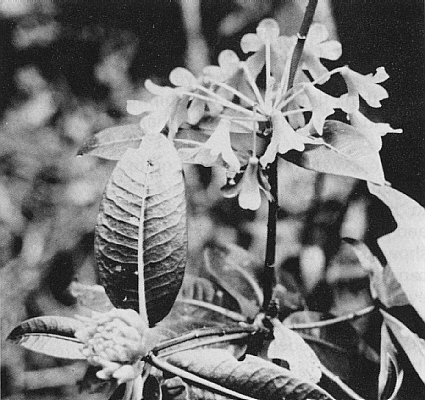
|
|
R. crassifolium
In the botanical garden at Park Headquarters |
From the radio-TV complex we went down to Park Headquarters. Besides the
R. brookeanum
var.
gracile
, their botanical garden included
R. crassifolium
, with its strange buds. These were broad clusters of unopened flowers, somewhat like dahlia buds, and a beautiful coral pink in color. Wild plants of this species were growing nearby, on large boulders in the middle of a stream.
During our brief stay at one of the Headquarters chalets, our main concern was to get all plant material packaged and ready to mail before we returned to the hot lowlands. After finishing this job we wanted to do the mailing as soon as possible, and we were happy when our driver arrived ahead of schedule on the day of our return to Kota Kinabalu. We got there in time for a slightly late lunch, and I had the rest of the afternoon to become very familiar with Malaysian procedures for registered airmail packages (14, that day).
As when we were preparing to go up the mountain, we maintained our energy and our spirits with early-morning breakfasts and after-dark dinners on the garden terrace of the story book tropical hotel where we stayed. This was the Borneo, four miles from the city center and beside Tanjong Aru Beach. Meals were up to the best U.S. standards, but cost about one-third as much.
Looking back at the trip, our job seemed incomplete, since we'd planned to examine the mountainside via two separate routes but had been unable to do so. Our additional approach would have been via the Mesilau East River, proceeding to the famous rhododendron areas above Mesilau Cave (elev. 6400 feet) and perhaps beyond. This would have led us to several species we did not see, such as
R. nervulosum
and
R. polyanthemum
. However, we could appreciate that there were concerns about reopening this trail.
One of the pleasant features of our trip was the weather. Before going, we had queried several sources about seasonal changes, but the replies indicated no consistent pattern. The only specific information we had was from Gibbs' account of her 1910 expedition, and her figures indicated a very sharp drop in rainfall during September before the start of the northeast monsoon. This information was close to the mark for 1976; we had only one really bad day, and our other weather varied from tolerable to excellent - most often the latter. Also, as Mr. Jenkins had told us, the fog and mist tend to clear with the start of the monsoon. Thus, from our temporary home at 10,800 feet, we often had beautiful views which included the seacoast, 30 to 50 miles away.
We saw flowers on nearly all the rhododendron species encountered but were forced to conclude that September-October is not a good time for seed collecting. Only two or three species had capsules at a good stage of ripeness. However, we picked all which seemed to offer any possibilities, and these are being distributed by the American Rhododendron Society Seed Exchange; also we sent a portion to the U.S. National Arboretum for planting and for distribution to other institutions.
We were glad that we also had permission to take cuttings; these went to ourselves and two other recipients in the U.S.A. The objective is to bring them along as rapidly as possible and then get them into general circulation. Another share went to the Australian Rhododendron Society, whose members seem determined to have all their good plants propagated in the U.S.A.
The Seattle Plant Quarantine Office of the U.S. Department of Agriculture was as kind and cooperative as ever, and I think that most of our shipments were in their hands for less than two hours.
A final word of praise must go to Canadian Pacific Air. Our last four flights to Japan had been via another airline and more ordeal than pleasure, but CP showed us that the trans-Pacific flight can be an enjoyable part of the trip, even on a very full 747.
Malesian Rhododendrons referred to in the text:
Section Vireya (BI.) Copel. f.
Subsection Pseudovireya (Clarke) Sleum
.
R. ericoides
Low ex Hook. f.
R. quadrasianum
Vidal
var.
cuneifolium
(Stapf) Copel. f.
Subsection Malayovireya Sleum.
R. fallacinum
Sleum.
R. acuminatum
Hook. f.
Subsection Euvireya Copel. f.
Series Stenophylla Sleum.
R. stenophyllum
Hook. f. ex Becc.
Series Buxifolia Sleum.
R. buxifolium
Low ex Hook. f.
var.
buxifolium
var.
robustum
Sleum.
Series Javanica Sleum
.
R. rugosum
Low ex Hook. f.
var.
rugosum
var.
coriifolium
(Sleum.) Sleum.
R. crassifolium
Stapf.
R. polyanthemum
Sleum.
R. maxwellii
Gibbs
R. nervulosum
Sleum.
R. retivenium
Sleum.
R. lowii
Hook. f.
R. brookeanum
Low ex Lindl.
var.
gracile
(Low ex Lindl. Henslow, J. R.
References Consulted:
Allen, E. F., "The Collection and Cultivation of Sabah Rhododendrons",
Quar. Bull. Amer. Rhod. Soc.
, 23, pt. 4 (1969), pp. 209-212.
Allen, E. F., "Rhododendron brookeanum 'Mandarin' "
Jour. Roy. Hort. Soc.
, 95, pt. , 5 (1970), pp. 229-230.
Allen, E. F., "Collecting and Growing Sabah Rhododendrons",
Roy. Hort. Soc. Rhododendron and Camellia Year Book
, 1971, No. 25, pp. 9-19.
Corner, E. J. H. and others, "Royal Society Expedition to North Borneo 1961: Reports",
Proc. Lynn. Soc. Lond.
, 175, 1 (1962-63), pp. 9-56.
Corner, E. J. H. and others, "A Discussion on the results of the Royal Society Expedition to North Borneo, 1961 ",
Proc. Roy. Soc.
, B, 161 (1964), pp. 1-91.
Corner, E. J. H., "Mount Kinabalu East",
Sabah Soc. Jour.
, 4 (1965), pp. 170-187.
Gibbs, L. S., "A Contribution to the Flora and Plant Formations of Mount Kinabalu and the Highlands of British North Borneo",
Jour. Linn. Soc.
(Bot.)
, 42 (1914), pp. 1-240.
Jacobs, M., "Plant Life on Mount Kinabalu",
Malay. Nature Jour.
, 15, no. 3 & 4 (1961), pp. 134-140.
Jenkins D. V. "The First Ascent of Mt. Kinabalu",
Malay. Nature Jour.
, 24, pt. 3 & 4 (1971), pp. 190-191.
Meijer, W., "A Botanical Guide to the Flora of Mount Kinabalu", in
Symposium on Ecological Research in Humid Tropics Vegetation
, Govt. of Sarawak and UNESCO, Kuchin9, Sarawak (1963), pp. 325-359.
Sleumer, H., "Rhododendron in Borneo and Thailand",
1965 Yearbook of Rhododendron-Gesellschaft
, Bremen, Germany, pp. 7-27.
Sleumer, H.,
An Account of Rhododendron in Malesia
(Partly a reprint from
Flora Malesiana
, ser. I, vol. 6, part 4, Jan. 1966, pp. 473-674), P. Noordhoff, Groningen, The Netherlands.
Sleumer, H. "New Species and Noteworthy Records of Rhododendron in Malesia (Ericaceae)",
Blumea
, 21 (1973), pp. 357-376.
Stapf, O., "On the Flora of Mount Kinabalu, in North Borneo",
Trans. Linn. Soc. Lond., 2nd ser., , Bot.
, (1894), pp. 69-263.
